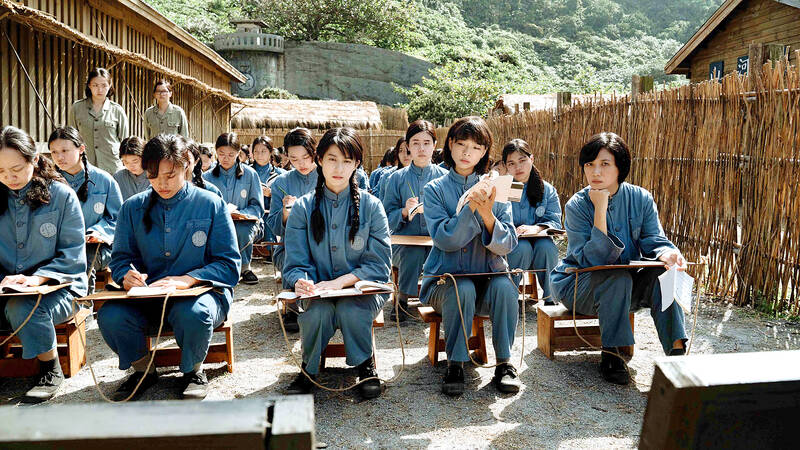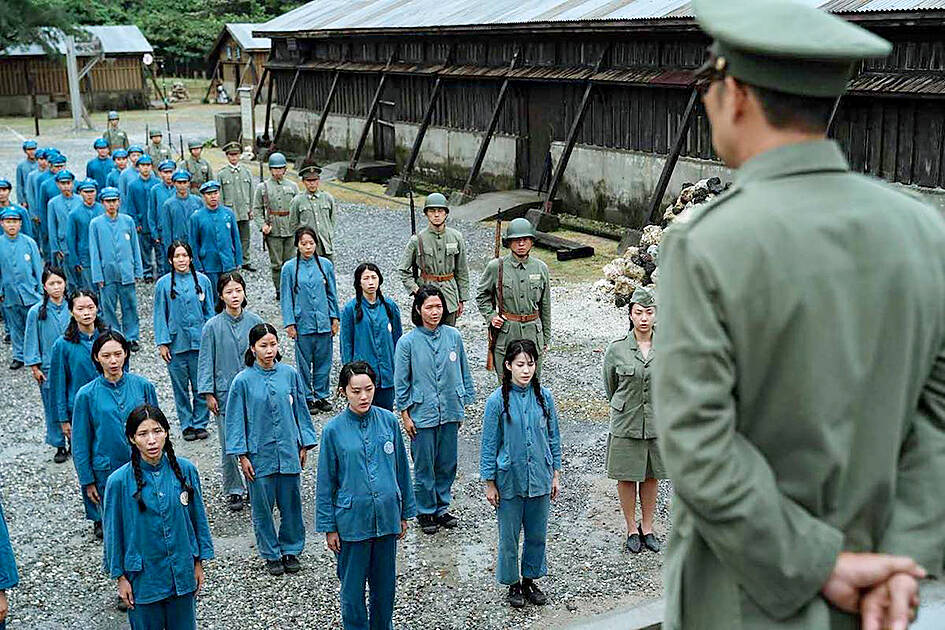Having read the book featuring the true stories Untold Herstory (流麻溝十五號) draws from, it was interesting to see how director Zero Chou (周美玲) took bits and pieces of these experiences and weaved them into a dramatic narrative.
While there’s been much effort in recent decades to highlight the long-suppressed history of the thousands of political prisoners once confined on Green Island (then-known as Bonfire Island, 火燒島), an often-forgotten part is the nearly 100 female prisoners who toiled there. Mostly imprisoned in gated barracks, they were only let out to attend “re-education” classes and perform hard labor.
Many of them were still students, suddenly nabbed and dragged away during the height of White Terror for innocuous offenses such as reading banned books, saying something that may be interpreted as pro-communist or simply knowing the wrong people. Some were reported by people they had offended as a form of revenge. Records show that 26 women were executed for their “crimes,” but the actual number is likely higher.

Photo courtesy of Activator Marketing Co
It was taboo to discuss the issue for decades, especially as those released still faced social stigma and government surveillance. Many refused to talk about it even after the lifting of martial law. Fortunately, five of them opened up to Tsao Chin-jung (曹欽榮) for the book, providing an invaluable glimpse of the horrors and hardships they witnessed and endured. Tsao, who has been researching the White Terror for decades and led the planning for the Green Island White Terror Memorial Park and other projects, served as consultant to the film.
Shot delicately in muted, cool tones, the attention to detail in the film is impressive, from the painstakingly reconstructed camps and barracks, to the costuming, to the varying, heavy accents of the prisoners and guards. The Chinese Nationalist Party (KMT) guards came here from all across China, while the Taiwanese were just beginning to learn Mandarin — this, in addition to the terminology they use, is handled very well.
Three fictional protagonists were created for the story: the young and innocent Kyoko (Yu Pei-jen, 余佩真) who sketches everything she sees, the wistful dancer Chen Ping (Cindy Lien, 連俞涵), who catches the eye of the top commander and Yen Shui-hsia (Herb Hsu, 徐麗雯), a strong-willed Christian mother and nurse who refuses to bow down to authorities. Chen is one of hundreds of students from China’s Shandong Province accused of sedition in the 713 Penghu Incident, and it’s important to highlight that those from China (“mainlanders”) were also subject to White Terror abuse.

Photo courtesy of Activator Marketing Co
One can roughly tell which women from the book they’re based on, but they’re distinct enough and draw from a multitude of accounts. There were never more than 100 women incarcerated on Green Island at a time, but the prisoners’ assigned numbers in the film were all in the 100s. Chou says in an interview that this is done purposely to avoid revealing the names of the political prisoners.
The central event of the film is the “Save the Nation with Good Conscience Movement” (一人一事良心救國運動), which included pledges “volunteering” to tattoo anti-communist slogans on their body. The mass refusal to participate eventually culminated in the “re-rebellion” case (再叛亂), where 14 people were executed.
As a mainstream feature film, the overall story and events are a bit melodramatic, but that’s what pleases movie-goers and helps bring more attention to this forgotten history. The historical elements are presented well and are smoothly incorporated into the narrative, and it helps that they come from detailed oral accounts that include the emotions the subjects felt during certain events. The general political atmosphere of the times is also reflected through the newspaper clippings the prisoners secretly save as well as conversations between those who run the prison.
Despite the state’s attempts to dehumanize and brainwash the prisoners, the film emphasizes their interactions, camaraderie and humanity as they each try to retain their sanity and dignity in different ways.
Overall, it’s a powerful statement and ode to these women and their will to endure the most difficult situations. Two of the women in the book spent more than 12 years locked up on bogus charges, but there was nothing they could do but carry on with life after getting out. If you can read Chinese, definitely pick up the book after watching the film.

Taiwan can often feel woefully behind on global trends, from fashion to food, and influences can sometimes feel like the last on the metaphorical bandwagon. In the West, suddenly every burger is being smashed and honey has become “hot” and we’re all drinking orange wine. But it took a good while for a smash burger in Taipei to come across my radar. For the uninitiated, a smash burger is, well, a normal burger patty but smashed flat. Originally, I didn’t understand. Surely the best part of a burger is the thick patty with all the juiciness of the beef, the

This year’s Miss Universe in Thailand has been marred by ugly drama, with allegations of an insult to a beauty queen’s intellect, a walkout by pageant contestants and a tearful tantrum by the host. More than 120 women from across the world have gathered in Thailand, vying to be crowned Miss Universe in a contest considered one of the “big four” of global beauty pageants. But the runup has been dominated by the off-stage antics of the coiffed contestants and their Thai hosts, escalating into a feminist firestorm drawing the attention of Mexico’s president. On Tuesday, Mexican delegate Fatima Bosch staged a

The ultimate goal of the Chinese Communist Party (CCP) is the total and overwhelming domination of everything within the sphere of what it considers China and deems as theirs. All decision-making by the CCP must be understood through that lens. Any decision made is to entrench — or ideally expand that power. They are fiercely hostile to anything that weakens or compromises their control of “China.” By design, they will stop at nothing to ensure that there is no distinction between the CCP and the Chinese nation, people, culture, civilization, religion, economy, property, military or government — they are all subsidiary

Would you eat lab-grown chocolate? I requested a sample from California Cultured, a Sacramento-based company. Its chocolate, not yet commercially available, is made with techniques that have previously been used to synthesize other bioactive products like certain plant-derived pharmaceuticals for commercial sale. A few days later, it arrives. The morsel, barely bigger than a coffee bean, is supposed to be the flavor equivalent of a 70 percent to 80 percent dark chocolate. I tear open its sealed packet and a chocolatey aroma escapes — so far, so good. I pop it in my mouth. Slightly waxy and distinctly bitter, it boasts those bright,